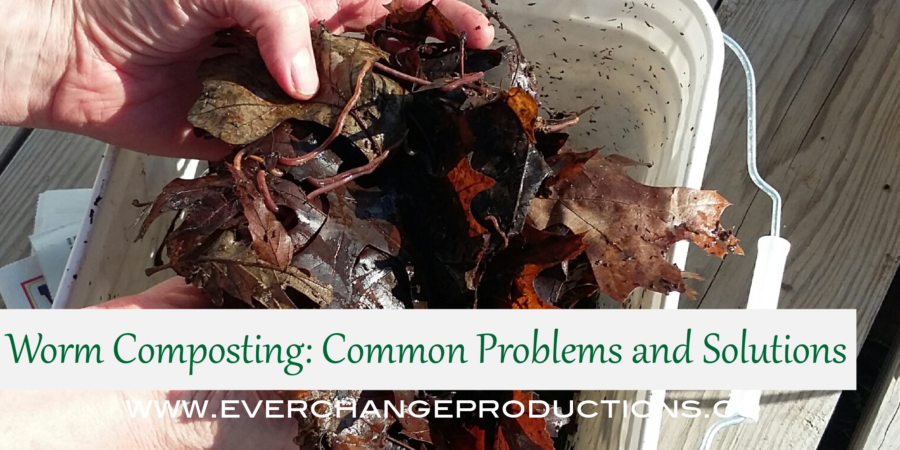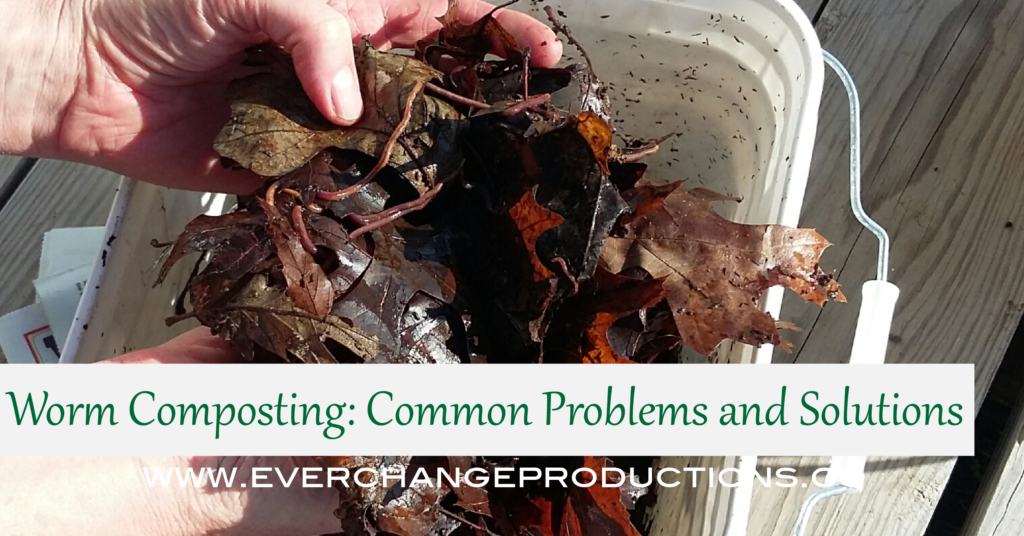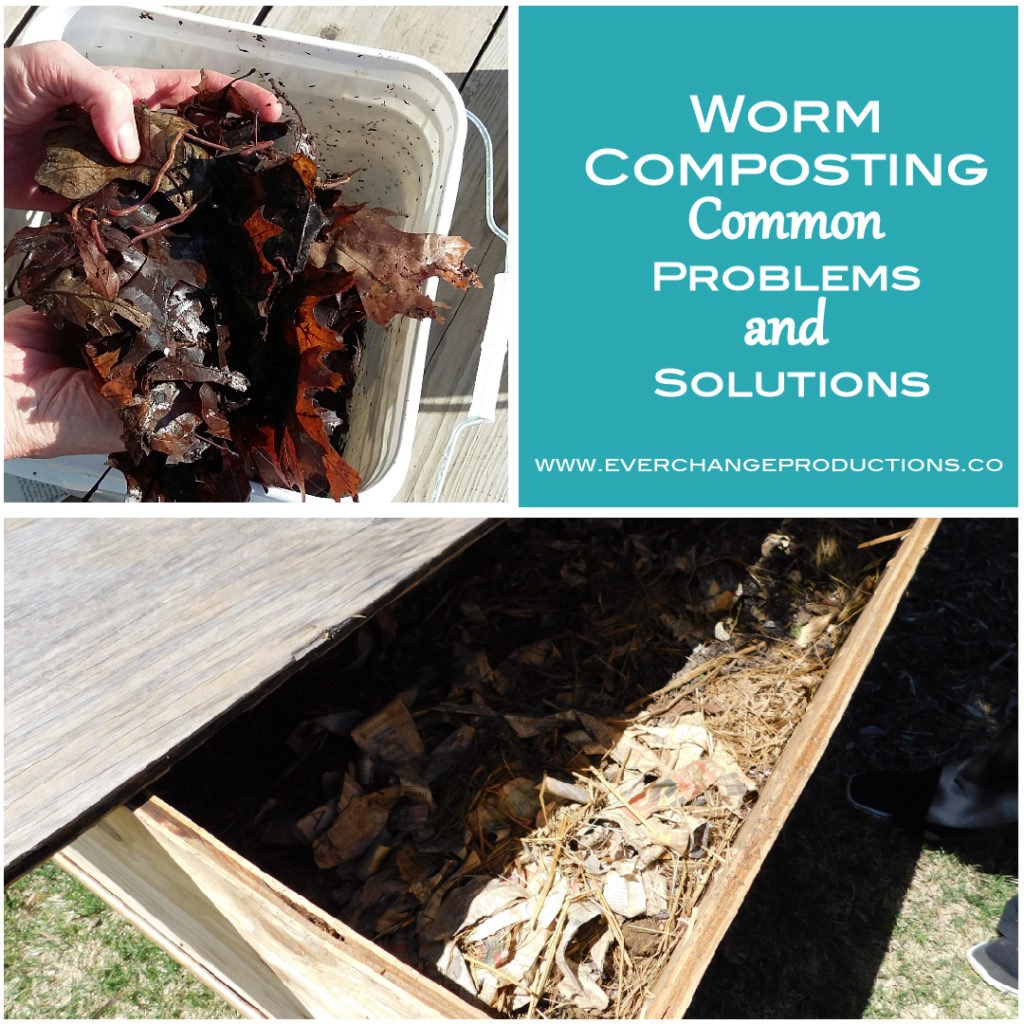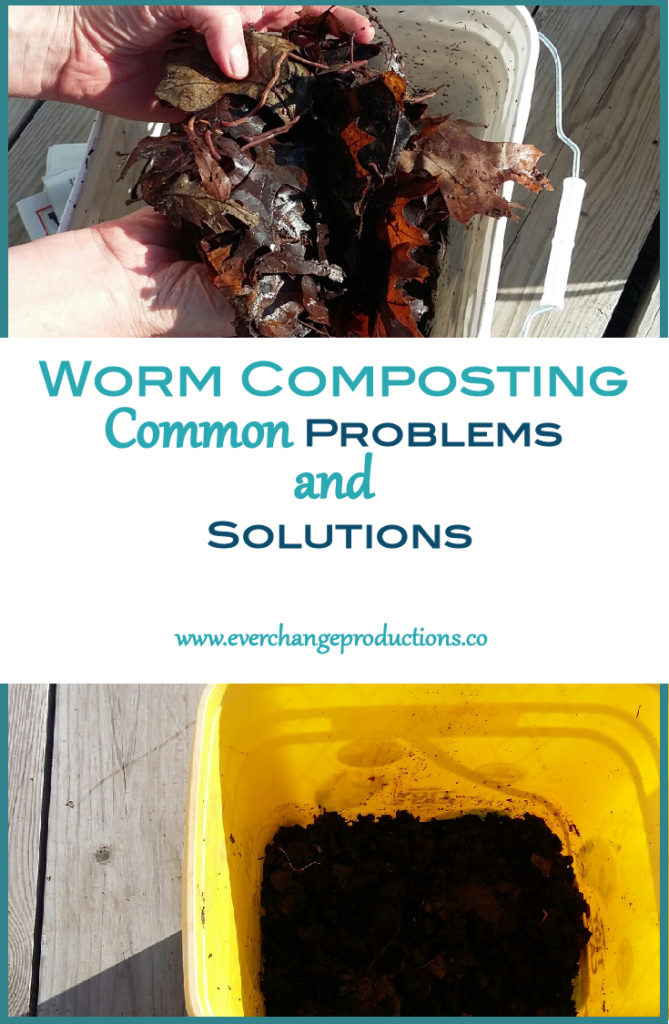So you’ve started worm composting, but you’ve hit a few bumps in the road. Maybe all your worms died, or it’s starting to stink- what do you do? Throw everything out and give up? I certainly hope not. Worm composting is such a great composting solution for those who live in small spaces, rent or don’t have a yard. It might even be your only composting option, so don’t give up on it quite yet. Worm bins are incredibly simple eco-systems. There are some key vermicomposting basics, such as knowing what to feed your worms, but usually any problems that come up have easy fixes.
If you’re interested in learning how to start a worm bin, from start to finish, check out this 2-part vermicomposting video series.
Common Worm Bin Problems
An established worm composting bin is essentially a self-contained ecosystem that will survive as long as you provide it food. Despite this, a few things can occasionally go wrong. Read on to learn about common problems associated with vermicomposting and how to handle them.
House Flies in Worm Bin
Flies will only become a nuisance if there is something in the bin that they want to eat. To get rid of fruit flies in worm bin, make sure the food is covered. If food added to the bin is covered, flies should not be a problem.
Worms Crawling Up Sides of Bin/Escaping Worms
If your worms are deserting your bin, something is wrong with their living conditions. If the food is plentiful, the bedding has the right moisture content and the farm is well-ventilated, your worms won’t have any reason or need to escape.
In my experience, escaping worms usually means it’s too wet and water is collecting in the bottom. In this case, I dumped out the excess water and added dry bedding to help dry it out.
If you have a larger worm bin or wood bin, the opposite might be the case. The worms might need more air, so make sure to add enough air holes.
Another cause for escaping worms is the acid level in the bedding. Adding a little garden lime to the bedding should neutralize the excess. Cut down the amount of citrus peel you are adding to the compost.
Worm Bin Too Wet
If you use a small system like stacked kitty litter buckets, a common problem is the worm bin getting too wet. In my case, I always added water when I added dried bedding. But after time, I realized even that was too much. As the food decomposes, it gets soggy and wet, which is often enough water in such a small, plastic environment. If necessary add more drainage and air holes, and add more dry bedding when you add food.
Worm Bin is Too Dry
If you use a larger bucket system or a wood bin, the last section of extra precautions aren’t necessary.
But dry bedding is no good for worms. Make sure it is always moist. Sprinkle or spray with water if it appears or feels dry.
The Worm Farm Smells
Always bury the food you add or cover it with a layer of bedding. Otherwise, unpleasant smells will begin to emanate from your bin.
The Worm Farms Smells Very Bad
Too much food being added to the bin can cause a terrible odor. Do not treat the worm bin like a trash bin. Only add as much food as the worms can eat at a given time. If food sits in the bin too long it will start to rot. The rotting process will deplete the oxygen in the bin and increase the amount of liquid.
Give the worms time to clear the food backlog before adding any more. If you find that you have an excess of waste, consider building another worm bin.
Worm Bin is Moldy
Ensure that the bedding is only adequately moist and that the bin is well-ventilated. You might also be adding too much food, so make sure the worms eat their previous meals before adding more.
The Number of Worms is Declining, But They Aren’t Dying
This might be common for an outdoor setup. Worms are a favorite food for many small animals like birds, mice and frogs. If you notice your worm numbers are falling, but that there does not seem to be a collection of dead bodies, there is probably a predator at work. Check your bin to see if there are any signs of an entrance. Rats and mice can chew through plastic easily, and don’t need very much space to move.
If there is no obvious point of entry, make sure the top of the bin is held securely in place. That will probably solve the problem. Consider installing a latch or securing the bin with rope or bungee cords.
If worms are dying, but none of these seem to be the cause, double check what you feed them. Worms can’t eat all the normal composting materials. It might just be as easy as changing their diet.
Interested in composting, but don’t know where to start? Subscribe for access to a free quiz and find the best composting option for you.
Worm Composting Troubleshoot Conclusion
As you can see, most worm composting problems have a simple fix. All it takes is a little investigation and then a little change in direction. Leave a comment with any worm composting troubleshooting problems you have and I’ll be sure to add a section about it.
Here is a quick reference guide to troubleshooting your worm bin. Save this pin for later!
Don’t forget to pin this information for later!





Such helpful information. Thank you! We are planning to start worm composting in our preschool this summer and this will be so helpful!
Found Bright yellow fungus?? growing on top of newspaper in top bin. Removed it and few days later it’s on the underside of the bin lid and along most of one side of the bin.
Looks exactly like leaf pattern – which makes me think it’s a fungus growing.
Dangerous?
Recommendations?
Molds and fungi are often part of the composting process. I don’t have experience with that type of fungus directly, but you might want to slow down on the food scraps your adding or add more shredded paper, card board, etc.
This is an article I found about yellow mold, it gives some types and how best to address it. Thanks for reading! https://findanyanswer.com/what-is-a-bright-yellow-fungus
Thanks for the follow up and the reading materials. We have a friend that was a research professor ( Biology – her specialty was the sex lives of ferns – no kidding!!) at Purdue. I sent her a picture of the mold and she ID’d it immediately.
I added shredded paper and some sawdust/wood shavings to the top bin and it dried things up nicely. I’m using stackable bins and have seen quite a few worms in the upper bin, but still a lot in the lower bin.
It’s an intriguing process – anything to help with the compostable materials we produce (vegetarians). I still use a spinner composter as well as a wire “bin” to layer compostables and leaves.
Thanks again.
Clayton Richard
Awesome, mind sharing what the ID of it was? I’ve never seen anything like that before. I’m glad that your enjoying your compost. I think it’s pretty fascinating as well.